Episode #3: At Verloop io, all roads lead to content
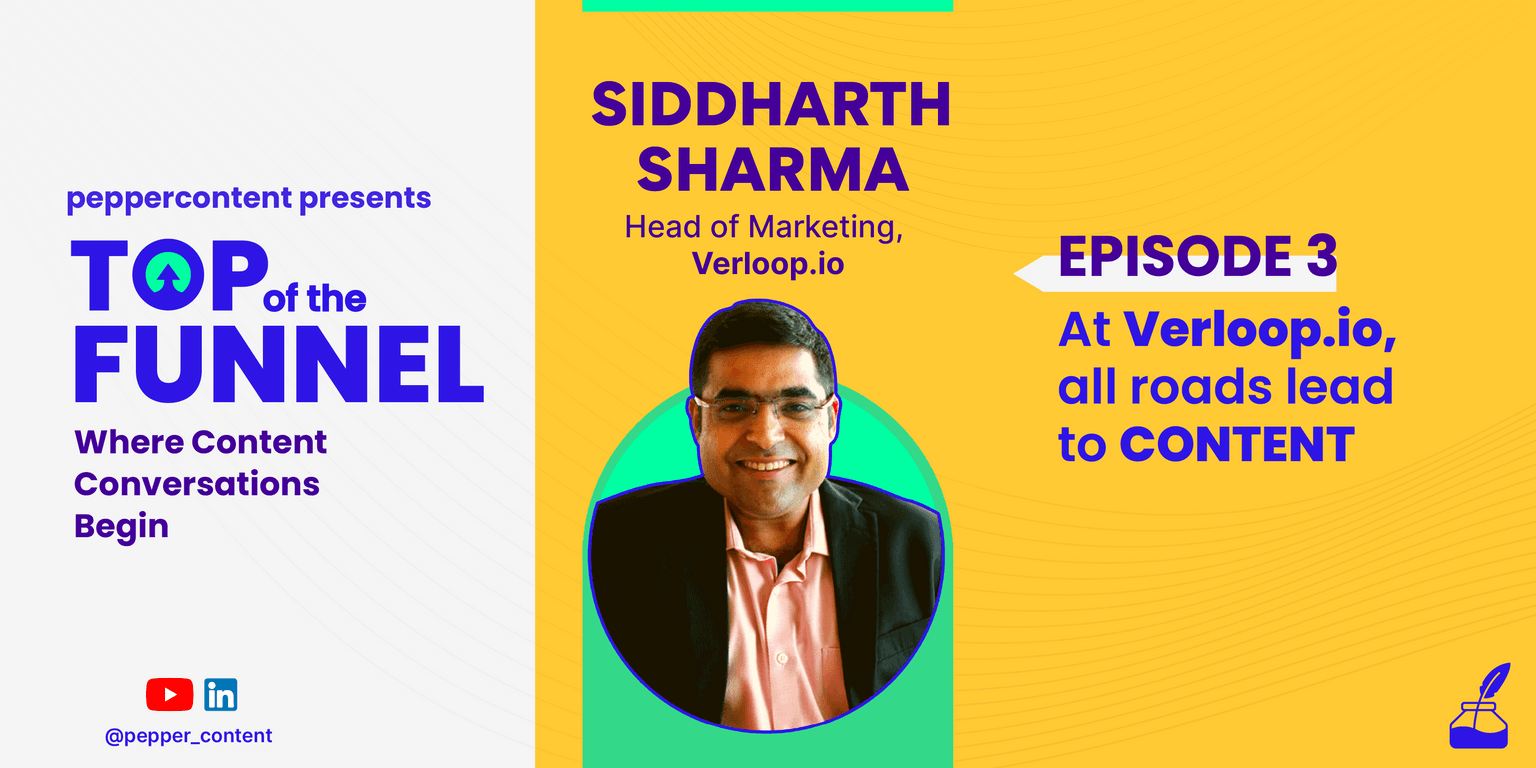
Natasha Puri, Content Marketing lead at Pepper Content, talks to Siddharth Sharma, Head of Marketing at Verloop, an e-commerce platform that caters to the needs of companies to automate customer support and customer acquisition. He traces the trajectory of his dynamic career in marketing and gives valuable insights for upcoming marketers. He believes that content would be the core of business strategies in the future, and companies have to adapt their content to changing platforms.
Natasha Puri: Hello everyone. Welcome to the Top of the Funnel series, where content conversations begin. We invite senior marketing leaders all over the country, across all countries to talk us through the role of content in their businesses. From meeting rooms to board rooms, everyone wants to know the content plan. This is the change that we are here to capture in the Top of the Funnel series.
Verloop is a conversational support platform that caters to companies like Clear Trip, Nyaaka, Decathlon, just to name a few. Our guest, Siddharth Sharma, the Head of Marketing at Verloop, has over 12 years of experience helping organizations achieve results and scale from marketing. Having worked at companies like Clever Tap, Simply Learn, Money Pal, I am certain that Siddharth’s insights would be super valuable to us.
Would you walk us through your journey from starting in marketing to now, being a marketing leader?
Siddharth Sharma: I had a very atypical non-linear career. After finishing engineering, I worked as a front-end and back-end developer at Infosys. I did a lot of projects there. Then, I moved to pre-sales. Then, I did my MBA. It is an age-old saying in India that if you are confused after your 12th standard, you do engineering. If you are still confused, you get into an IT services company like Infosys, TCS, Wipro. And, if you are still confused, you do an MBA. Even then, if you are confused, you take up marketing. So, it was like that for me. I got all the catch-alls. After I finished my MBA, I joined Money Pal.
Luck has played a huge factor in my career. I have been fortunate enough to work with really great and amazing leaders. I have had brilliant managers and amazing Chief Marketing Officers, whom I could talk to, and who would share their insights with me. I had the chance to observe the ‘mysterious madmen’, who work their craft every single day. I have been in close proximity to them. So, I learned a lot from there. I had never thought of making a career in marketing. I just liked the growth aspect of it. Coming from an engineering background, I wanted to see if I could program marketing to do what needs to be done.
Digital marketing took off then. As I said, I have been really lucky to have been in the right place at the right time. Digital took off at the beginning of my marketing career. So, I had a lot of head wins going into that. I used to work on APIs to run to send my email tool the information from my CRM, that I had hardcoded myself. So, after that, I worked with HubSpot and Markov and went into leadership marketing at Clever Tap. This has been my journey. I have had some great marketing ‘gurus’ trust in me to let me take up challenges, even when I had zero knowledge
Natasha Puri: You are being extra humble. But, let’s ignore that. What does leading marketing at Verloop look like? As I understand, it is an enterprise software company which means B2B Marketing. I would love for you to go deeper into B2B marketing. What is the role of content there?
Siddharth Sharma: I get this question quite often, as some people feel that B2B marketing does not have the right to exist, or B2C marketing is totally about sales. Marketing, in its functionality at its core, is ensuring that you can connect your brand to the right customers. You should be meaningful to them, and not in a way that appears intrusive. It should not be that you are pushing your brand name to them. Your target audience should know you in the space that they want to know you from. So, I work at an enterprise company like Verloop. If I am looking at a chief technology officer, who wants to automate customer support, I would want Verloop to be in that space.
I want them to think of Verloop when looking to automate customer support, not when they are choosing perfumes, or in any other space. It is about understanding the right space, being in the right context, and being aware. The tactics obviously differ in B2B and B2C but, overall the fact remains that you cater to your customers, in whichever space they are in. How am I able to drive revenue growth? How am I able to feed the sales engine that we have? How am I able to evangelize my organization to its existing customers? How am I able to leverage my existing customers to showcase my value to my prospects? How do I add value to any of my users?
There are multiple users- some who use a platform, and some who are admins of a platform. There are users who are the end customers of my client’s platform. We sell to a B2C organization, so there are a lot of end customers. How can I add value to their experience? How can my product bring some change in their lives? This is pretty much what leading marketing at Verloop looks like. Again, if we go deep into it, how is the growth and demand function? How is the content function? How is the product marketing? But, these are all various pillars of marketing. At the end of the day, it is about how well am I able to reach my prospects to best evangelize my current set of customers.
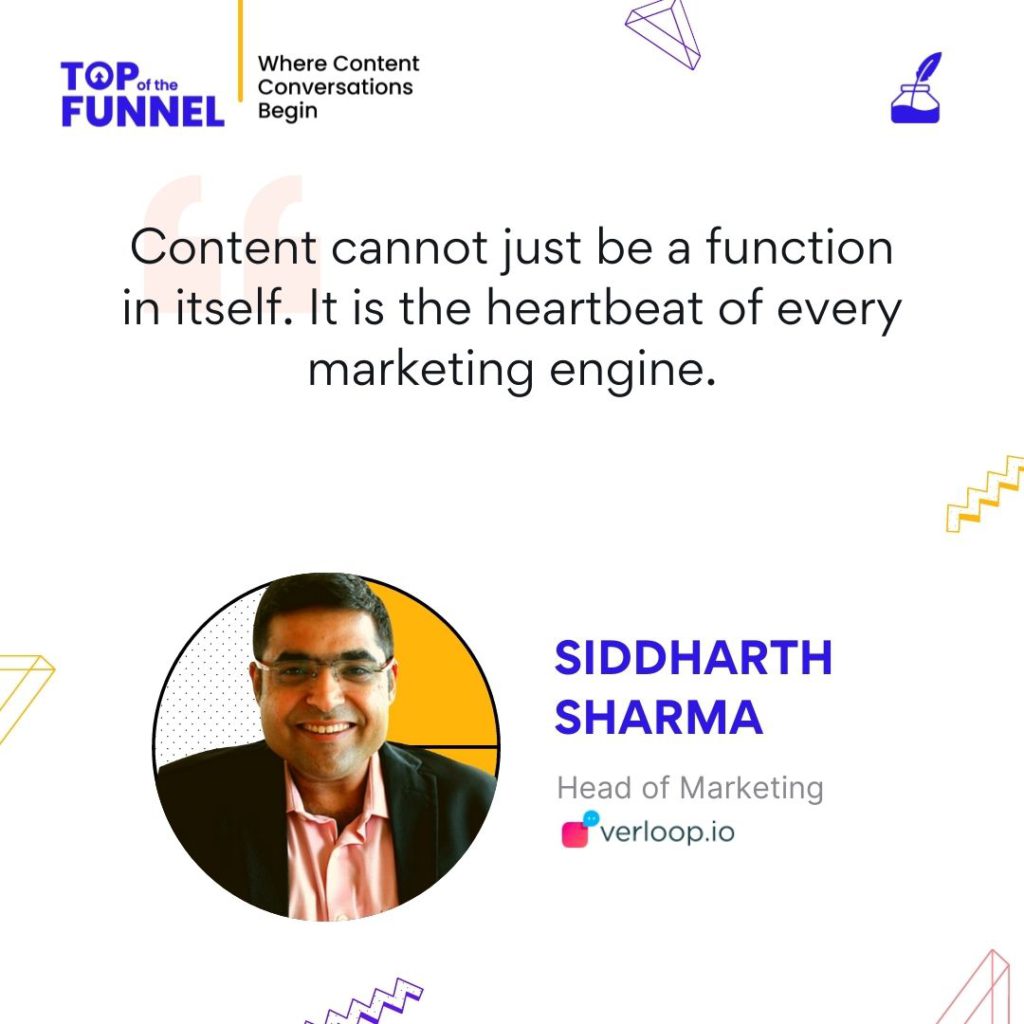
Natasha Puri: Content caters to all aspects of marketing from lead generation to CRM. It kind of plays a role everywhere. How does it work at Verloop? How has it changed, since you joined there?
Siddharth Sharma: Blog writing was quite an inessential part of marketing during the early days of 2008-2009. Content is the heart of our marketing machine now. I had a discussion recently with a content marketer, Akshita from MoEngage, whom I admire very much.
Natasha Puri: We interviewed her recently!
Siddharth Sharma: That’s great. I look up to her a lot. We converse quite frequently. In one of our conversations, we were discussing that marketing owns two functions-production and distribution. It may sound a bit old, but without production, there is no distribution. Your distribution may not be effective, but at least you have produced something. Imagine you are laying down a train rail. The train may not yet run on it, but at least you have provided the rails. Imagine if you do not even lay down the rails, which are the content. The distribution comes later.
In marketing terminology, production is the content. Whether you are creating copies for your landing page, or ads for your Linkedin page, creating blogs or e-books, or whatever, this production goes back to the role that content plays in marketing. In my opinion, content plays a major role. All the KPIs that a marketing director holds are owned by the content itself.
To evangelize your current customer, you go for product marketing. If you want to convert more customers, you have demand generation like content-specific ads or your landing page for your prospects to come down and fill up a form. If you want to build brand awareness, your video clips should be great enough for your brand to hit home, to convey what you are and what you are claiming to bring forth to your customers. It is the heartbeat of every marketing engine. Content cannot just be a function in itself. It is everywhere.
Natasha Puri: The idea of content has changed in the last few years. Marketers are storytellers now. Content has assumed an important position at the forefront of every brand campaign. When you are building a team of marketers, has your approach to hiring new people changed? What are the top two to three things you look for when hiring marketers?
Siddharth Sharma: It depends on what I am hiring for. When I am looking for content marketers, one of the things that I look out for is what they are passionate about, and what they have written before. If they have managed to communicate what they wanted to say in a way that the end-user understood, then their craft has been honed very well.
I also look at what have they worked on. Eight years back, it was not possible for everyone to have access to a good camera or a good recording device. In 2011, a good microphone was hard to come by. Even wireless headphones were a luxury in 2011, for a lot of kids like me. With the cost of equipment coming down, it is easier for everyone to have access to good equipment. I make it a point to look at the medium they have used to express themselves.
For example, if they run a podcast, or write about their side-hustle in a blog, I want to know their story. If someone cannot tell me their own story, they won’t be able to tell my brand story. If you are not passionate about telling your story, I cannot tell if you would be able to tell mine. This is very qualitative. Your methods may be different. But, I do this. I also give them feedback. I tell them what I was looking for. I could be wrong, but I tell them my opinions on their profile. Either you are not a great fit for us, or we are not a great fit for you. It could be either of the cases. This is how I go about hiring marketers, especially for content.
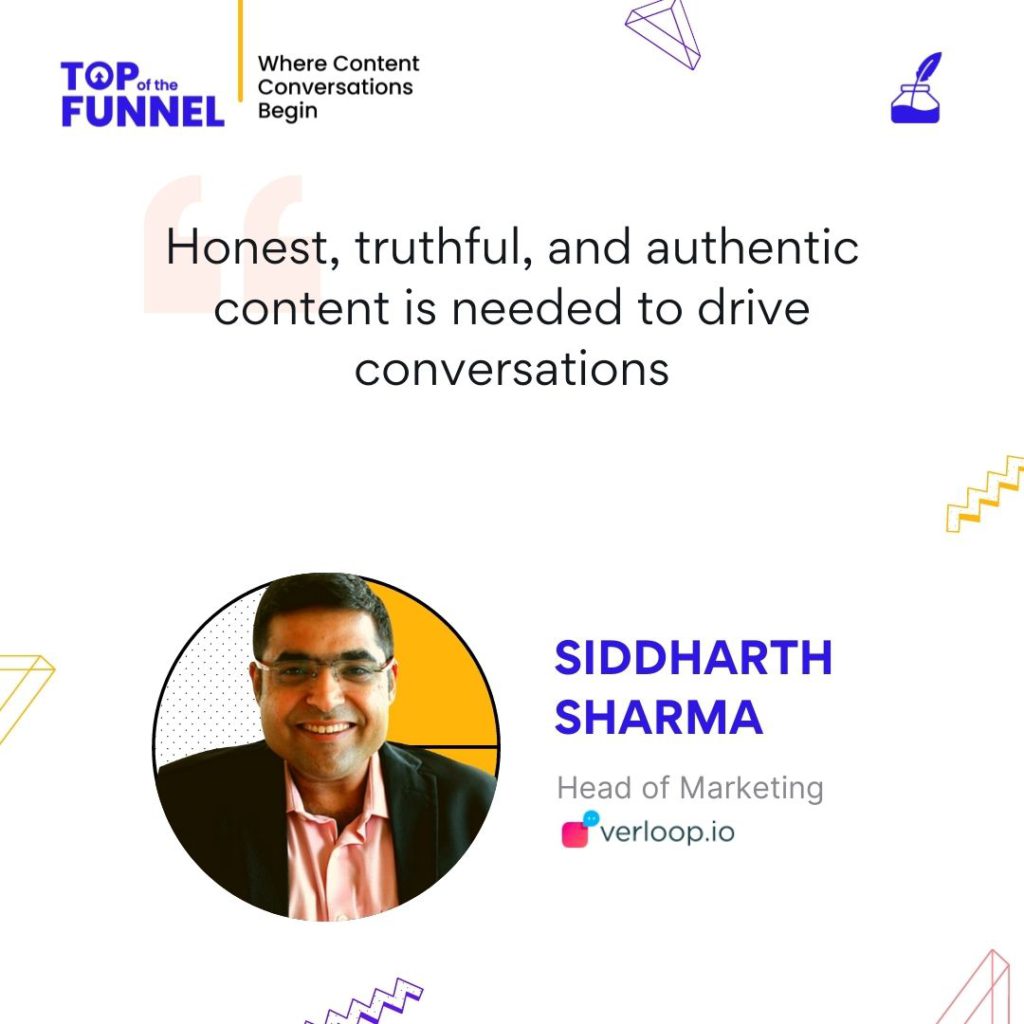
Natasha Puri: I noticed that you also have a podcast. You have a very active Linkedin profile. You are also pushing out content in these places. A lot of people have started to indulge in personal branding. Storytelling is not just limited to brands. It is about our own personal brand too.
How important has it become for brands and individuals to embrace content creation as a way of life? How much of what you are doing personally impacts your marketing strategies at work, and vice versa?
Siddharth Sharma: Your focus should always be on authenticity. You should not do a podcast just because someone else is doing it. You should do a podcast because you have some valuable content that you want to share with the world, and your target audience is in that space. Now, if my audience is on Instagram, my brand should be on Instagram. I do not have to be on Instagram necessarily. But, it helps if I am, as it adds more authenticity to my brand.
With the way content is created now, brands have to adapt to a lot of formats and platforms. Buyers are changing. People are no longer interested in a comparison feature-by-feature sheet. A lot of mind shifts and decisions for big-ticket B2B clients are created through content. Many companies like CRC and CR4 look at how you can build a Whatsapp bot. If you make videos well, you have to manage to create a space in their heads. Brands should own it up. When you are being authentic and putting yourselves out in the world, you carry a message.
The product at the end of the day has to deliver value. You might be the best marketer in the world, but the product has to offer value. My personal content creation impacts the brand, but not to such a large extent. An amazing marketing officer cannot pass off bad-quality products to their audience. People will move on from your product after three months.
Nobody wants to invest in a bad product. Whatever I do in my organization definitely impacts the way I look at the world. I spend a great deal of my time working for my organization. If I feel that people are engaging in some format better, I bring it to my personal space too. There is no such hardcore difference in my approach.
Natasha Puri: What are the biggest challenges that you have faced while implementing content marketing in your organization? It does not have to be restricted to Verloop. What are the obstacles that you have faced in your career in marketing so far?
Siddharth Sharma: One of the foremost hurdles that marketers have to overcome is the way they communicate their strategy. I will be honest. I have not always been the best at it. Marketing can do a myriad of things. It boils down to what you want to do with it. You do not want to start a community at Clubhouse without knowing how you are going to grow and sustain a community there. One of the biggest challenges that marketers have to prove is that they bring value to an organization. It is always an uphill battle.
Natasha Puri: Now there is a buzz for it. But, there was a time when content marketers meant content writers only.
Siddharth Sharma: I, myself am guilty of it. When I wanted to hire someone in 2013 or 2014, I put out a post saying that I wanted to hire content marketers. Somebody who had pushed through a lot was not a marketer, but an editor. I thought that if they can write, I can teach them the marketing bit. When I am about to roll out an offer letter, I have a session with them. And, I am very super clear on what I want them to, where they would be in a few months, and what I am planning for the upcoming 60 to 90 days.
The person on the other side of the call said that this is not what they had signed up for. I kept pushing that if they write content, these things will be sorted. But, that person would not budge. He said that he wanted to write good content. He did not want to focus on writing copy or landing pages. Thankfully, his senses were in the right place. He did not join. I realized what I was trying to do would not do well.
Natasha Puri: This is exactly what I feel when I see people hiring content strategists with two years of experience.
Siddharth Sharma: Awareness within the organization is very important. Most people cannot differentiate between content creation, content marketing, and content strategy. It is also not everyone’s cup of tea. If one is a good writer, why would one want to create a strategy? Many organizations are unclear about who they want to hire. Also, startups are more likely to hire anyone who can write content, as they do not know how to write content. Many may not agree to this, but they do not understand marketing. They think that marketing is like an auto-correct filter. If you click that, things would be perfect. Typically, it is assumed that when you do not get into any field, you choose marketing.
The curse of marketers is that there are also a bunch of marketers, who offer hacks to get 50,000 views in a day, one hack zero dollars investing strategies, zero dollar group business to millionaire hacks, and so on. This is the curse of internet marketing or blogs, where people read up blogs very fast and rephrase that for their audience, or apply hacks like full-scale enterprise marketing at zero dollars for their businesses.
Natasha Puri: We can say that content is a boon and a curse too. The same blog that could help someone, could also misinform someone.
Siddharth Sharma: I have written blogs, where my clients wanted to target their CEOs or other business leaders. I have a very simple way of tackling this. When somebody has written about a topic like how to apply enterprise marketing in their business, I call and ask them if their consultation is free. If they say it is a zero-dollar investment, I am good with this arrangement. If any such advice is free, it is probably worthless. A lot of folks want to read blogs that make it seem business would work by just hiring the right person. When asked if they would do their services for free if hired, they usually respond with something they have not shared in their blog.
However, founders probably have the best interest at heart, when they put out such job descriptions and blogs. They do not get the concept of marketing. Some cannot even differentiate between a reader and a writer, let alone a content writer and a content editor.
Usually, people do not have time. They want to solve a problem. They settle for silver when they have been promised gold to salvage a situation quickly. They do not want to go into the root of the problem at that time. When people are hired at a junior level, like right out of college, they try to step up to these challenges. It could lead to reinforced learning where a content writer could learn marketing. It feels kind of muddled up. But, it depends on the company leader, or marketing head to guide their team. What kind of elements do you need in your content team? You need to figure out if you need a content strategist, content writer, distributor, or marketing expert. You need to combine these elements to yield good results. It is very rare that a content writer can also do content marketing efficiently.
Natasha Puri: Are there any campaigns that you were super excited to conduct, with a content focus? You could talk about any of the organizations that you worked at.
Siddharth Sharma: One campaign that is super close to my heart is the benchmark report, that we launched for Verloop in the months of October-November. It was an e-commerce report. We took out data from the e-commerce work that was going on in our organization.
We brought out a report that detailed topics like customer satisfaction, agent handling, and so on, in an e-commerce setup. If you have a bot, what percentage of queries should the bot answer? What is the benchmark for it? When we looked for these questions, we did not find an answer. We launched it on Product Hunt, and it got a lot of love.
A lot of people called up from Operations to let us know that they liked the report. It felt like our distribution plan had gone smoothly. We reached the target audience. We also took out a hard copy of that report. It was a sellout. People came up to us and said that they wanted to read our report. It was one of my campaigns, that we did from conception to launch.
Another thing that I am quite proud of, that I consider my own doing, is the Verloop io podcast. We evangelized between Disha, the head of content marketing, and Anush, who hosted the podcast. We conceptualized the name, people who are going to speak, and so on, between the three of us. Within six episodes, we had 500 downloads. Two of these campaigns came to fruition recently. And, it felt really good.
Natasha Puri: Could you dwell on the benchmark report? Why was it such an important piece of content for you?
Siddharth Sharma: A majority of our audience is focused on customer support. However, when they are implementing a chatbot solution or even their day-to-day metrics, they only know about customer satisfaction for the queries they put out. They have access to their data, but not industry data. They will not have access to industry data until a player like Verloop comes into the picture. Verloop has 50 to 80 clients across the e-commerce space. They would break down the entire data, and tell the average, or industry-standard data. This is why probably it did so well. It told our customers what they wanted to hear. It helped them evaluate themselves as per the industry benchmark. They can ask internally if they are over-optimizing their resources.
Natasha Puri: I am assuming that your existing customers were happy because they got this report. And, it also impressed potential new customers. You are generating new leads with this report.
Siddharth Sharma: We spoke in the language our customers hear all the time and spoke of the metrics they do not have access to. When they are hearing something new, they figure out how to use these resources to optimize their chatbot or apply these in their benchmark report. It helps them keep a frame of mind when they look at these things. When someone downloads our report, we try to set up a meeting with them after a week or so and get feedback from them. It is not a sales pitch. We do it so that, our next report can be better.
Natasha Puri: It is a great piece of content that will last for a long time. It will keep giving. What do you think the future of content marketing is looking like?
Siddharth Sharma: Many content marketers are going to drive a lot of initiatives, more than they have done before. They are going to define strategies for a lot of businesses. If you think of marketing as a boat, content marketers would probably be the steer. If you want to focus on the top of the funnel content, the boat of marketing would go there. If you want to focus on the bottom of the funnel content, where can reach a lot of people, it would go there.
Marketing is going to be defined by content. Previously, marketing was divided into demand generation, brand management, PR. But, everything needs content now. In terms of outlook, it is ever-evolving. Five years earlier, people were just writing content. Now, different buzz words like content marketers and storytellers are in. Even now, a lot of job descriptions have opened up like podcaster, video producer.
Content creation, as a way to build community, had begun five years back. It died down, as it requires a lot of effort. Nowadays, I feel more and more brands are recognizing the importance of content to build a community, that drives revenue. Many organizations realized that if you provide value, people are going to buy from you. Pepper content, for example, when they build a community, focus on content marketers in and around themselves they can talk to.
Natasha Puri: It is a lot of value and information, rather than sales-focused. I hope that continues.
Siddharth Sharma: It will. A lot of marketers including chief marketing officers have realized the importance of content. It is no longer a part of a strategy, but the core of a strategy. You have to start from content, and it grows.
Natasha Puri: Thank you for making the time. I hope that the picture you painted continues to grow. People like me would remain relevant, and more and more people like me would come together to build a larger community of content marketers.
Latest Blogs
Explore how Google’s 2025 AI search updates triggered ranking chaos. Learn actionable strategies to adapt your SEO for AI Overviews, zero-click searches, and SERP volatility. Stay ahead now.
Learn how to rank on AI search engines like ChatGPT, Perplexity, and Gemini by optimizing your content for authority, structure, and relevance. Stay ahead in AI-driven search with this strategic guide.
Explore the best healthcare SEO services for your medical practice. Improve online visibility and effectively reach more patients in need of your services.
Get your hands on the latest news!
Similar Posts
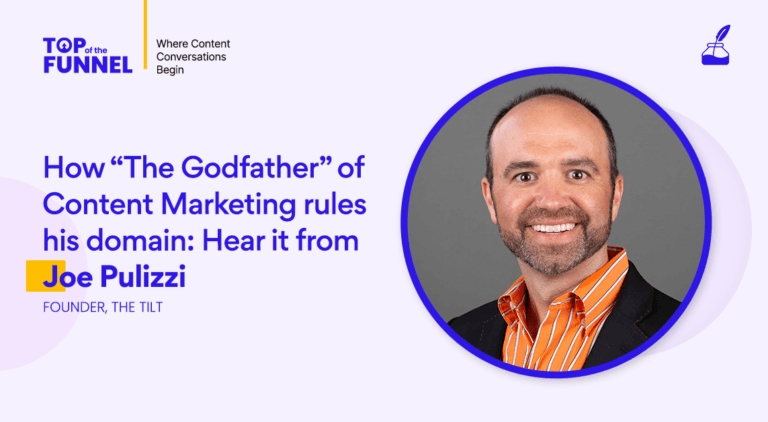
Expert Speak
18 mins read
Season 2 Episode #1 How “The Godfather” of Content Marketing Rules His Domain: Hear It From Joe Pulizzi
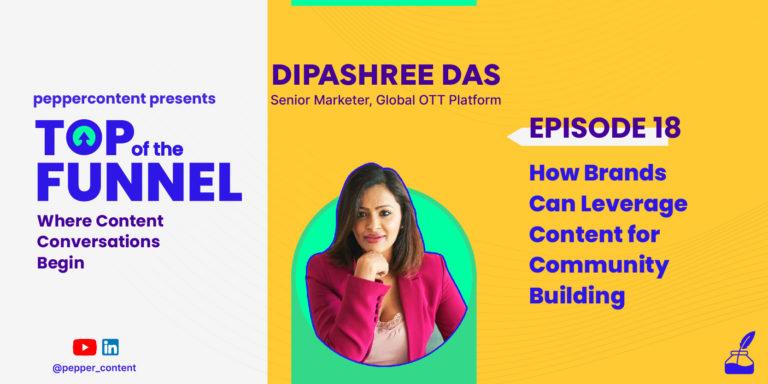
Expert Speak
16 mins read
Episode #18: How Brands Can Leverage Content for Community Building

Expert Speak
11 mins read